

Hello, I am Statusbaked, the current jungler for Phoenix Reign. This is a guide for how I play
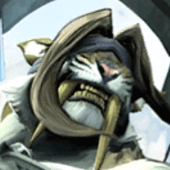 Glaive
Glaive successfully in both rank play and competitive matches.
I enjoy playing
 Glaive
Glaive because he is extremely versatile, and works well in almost any composition and with any support hero. He is extremely powerful in the mid-game, making it very easy to turn around and snowball matches once he hits his power spikes.
Glaive is a tanky melee bruiser with long range for a melee hero, one of the highest base health stats in the game at the cost of naturally low armor/shield. Feel free to be aggressive, but be careful of overextending.
I hope you enjoy the guide!
-Statusbaked

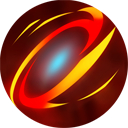 “Glaive’s critical strikes cleave in a 4 meter cone in front of him.”
“Glaive’s critical strikes cleave in a 4 meter cone in front of him.”
While not really noticeable visibly, Glaive’s perk gives him a lot of bonus damage that often goes unnoticed. When Glaive’s auto-attacks critically strike, he does Area of Effect (AOE) damage in front of him. This is incredibly useful while farming, and in team-fights when the enemy is close together. If the enemy groups together often, you can get more damage out of your perk by building crit items like Tyrant’s Monocle and max
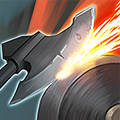 Twisted Stroke
Twisted Stroke for bonus cleave damage.

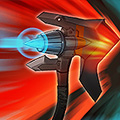 "Glaive rockets in the target direction, damaging all enemies along the way. His next basic attack is replaced by a frightening blast that knocks his target back 5.5 meters."
"Glaive rockets in the target direction, damaging all enemies along the way. His next basic attack is replaced by a frightening blast that knocks his target back 5.5 meters."
One of the best abilities in the game,
 Afterburn
Afterburn offers incredible utility, crowd control and escapability and is really the cornerstone of Glaive’s kit. In the early-mid game,
 Afterburn
Afterburn is often used for ganking the enemy laner. For a higher success rate, get a speed boost from something like Spring Boots or
 Vanguard
Vanguard and afterburn behind the enemy and “punt” him back towards your teammates.
 Afterburn
Afterburn is activated by basic attacking, and the direction is determined by where you click.
 Afterburn
Afterburn also gives a temporary speed boost after the dash complete, so If you are not in position to punt after the initial dash continue running with the speed boost to get behind the enemy and punt them backwards.
Good situations to use
 Afterburn:
Afterburn:
 Afterburn
Afterburn is such a versatile ability that it has many different potential uses. As described previously, it is an extremely good ganking tool, as well as a great disruptor in general. It is very easy to pick people off in jungle by Afterburning them into an unfavorable position. If possible, try to punt the target into a wall or structure for maximum disruption. Combo
 Afterburn
Afterburn with other crowd control abilities to pretty much guarantee a kill. With an extremely long dash combined with the bonus move speed,
 Afterburn
Afterburn is easily the best escape in the game. If in the correct position,
 Glaive
Glaive can
 Afterburn
Afterburn over ANY wall, making for flashy engages over walls or clutch escapes.
 Afterburn
Afterburn also has a relatively high burst of damage, making it very good for stealing objectives or jungle camps. In the late game,
 Afterburn
Afterburn is often best used to peel enemies off of your laner rather than as an engage tool.
Things to be careful of when using
 Afterburn:
Afterburn:
Be careful not to punt the enemy to safety by knocking them forward instead of backwards, as it could mean the difference between a kill and a narrow escape. Even with a relatively low cooldown, using
 Afterburn
Afterburn into the middle of an enemy team, especially in the late game, is often extremely dangerous. Instead of using
 Afterburn
Afterburn to engage, use it instead to escape if needed or peel for your teammates.
Upgrade Priority
In every situation, maxing
 Afterburn
Afterburn first is the best option. With such immense utility, it is incredibly useful to overdrive
 Afterburn
Afterburn first. With the overdrive, Afterburn’s cooldown is dramatically reduced and it gets an increase in damage.

 "Passive: Increase critical strike chance and AOE cleave damage of basic attacks.
"Passive: Increase critical strike chance and AOE cleave damage of basic attacks.
Activate: Instantly execute a critical strike. This deals weapon damage and is treated like a basic attack, but can deal bonus crystal damage if you have any crystal power. Cleave deals half damage to minions."
 Twisted Stroke
Twisted Stroke is a relatively simple ability, but is extremely useful in game. When used,
 Glaive
Glaive executes a basic attack that is guaranteed to critically strike. As previously described, Glaive’s critical strikes cleave in front of him, meaning it is extremely good against grouped up enemies and while farming. For maximum damage output, use it as a basic attack reset and use the combo: Basic attack—Twisted Stroke—Basic Attack. For a huge burst of damage, combo it with the basic attack punt on
 Afterburn
Afterburn. See the “Pro Tips!” section for more information on the execution of this combination. Oftentimes in team fights it is best to use the basic attack reset combination on the enemy carry for the guaranteed crit and a big burst of damage. While farming, use it on double minions for the AOE damage for a faster clear, and for stealing the last hit on enemy jungle camps.
Upgrade Priority:
Upgrading
 Twisted Stroke
Twisted Stroke gives it a lower cooldown in addition to increased cleave damage and crit chance. While these bonuses are extremely good, in most situations I would recommend not taking the overdrive on
 Twisted Stroke
Twisted Stroke. Only take the overdrive if the enemy is extremely squishy and you plan on building critical strike items, but that is not typically recommended in the current meta.

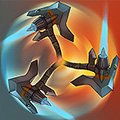 "Passive: Glaive will generate Bloodsong stacks from basic attacking or from receiving basic attacks. Each stack grants him bonus lifesteal. Max 20 stacks.
"Passive: Glaive will generate Bloodsong stacks from basic attacking or from receiving basic attacks. Each stack grants him bonus lifesteal. Max 20 stacks.
Activate: Swings Glaive's axe in a 5.4-meter circle, dealing massive area damage based on number of Bloodsong stacks used. This removes all stacks. Glaive also gains full stacks of Bloodsong whenever he dies."
 Bloodsong
Bloodsong is an interesting ability in that, given its passive, it is often best not to use it until the end of the fight. The passive and active effects of
 Bloodsong
Bloodsong are increased by the amount of stacks it has, stacking a maximum of 20 times.
 Bloodsong
Bloodsong stacks with basic attacks, so make sure you have 20 stacks before engaging a fight. Activating
 Bloodsong
Bloodsong makes
 Glaive
Glaive swing his axe in a wide circle, dealing massive damage. Try to use
 Bloodsong
Bloodsong when enemies are clumped up for massive AOE damage, or use the bonus range to take down escaping enemies.
Stacking
 Bloodsong
Bloodsong gives bonus damage on the activation, AND lifesteal on Glaive’s basic attacks/ultimate damage. Since activating
 Bloodsong
Bloodsong removes all stacks, in some situations it is best not to use
 Bloodsong
Bloodsong and keep the ~20% lifesteal. The extra lifesteal gives
 Glaive
Glaive a lot more survivability, allowing him to do more damage overall. However, that is not to say using
 Bloodsong
Bloodsong is bad, as it still does a LOT of damage, especially if you can land it onto a group of enemies.
Upgrade Priority:
Most of the time, it is best to max ultimate over
 Twisted Stroke
Twisted Stroke. The bonus damage you get from maxing it helps a lot, especially against squishy opponents.

Roam Heroes to pair
 Glaive with:
Glaive with:
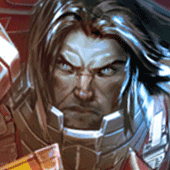 Ardan
Ardan-
 Ardan
Ardan is great to pair with
 Glaive
Glaive, as the bonus speed from
 Vanguard
Vanguard makes using
 Afterburn
Afterburn to knock an enemy out of position extremely easy. Use the speed boost to get ahead of people and knock them back/into an unfavorable position.
 Lyra
Lyra- Similar to
 Ardan
Ardan,
 Lyra
Lyra can use her A ability to speed
 Glaive
Glaive up for Afterburns, and the extra survivability/utility she provides is extremely helpful.
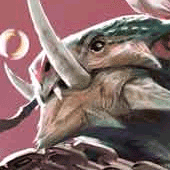 Phinn
Phinn-
 Phinn
Phinn is extremely good at engaging for
 Glaive
Glaive, allowing him to save his
 Afterburn
Afterburn. He pulls everyone nearby, and his AOE damage pairs nicely with
 Glaive
Glaive
pulls everyone nearby and has aoe damage. aoe synergy
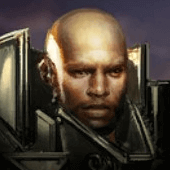 Lance
Lance- Combos are hard to pull off, but are very rewarding when done successfully. A Root+ Afterburn combo is deadly.
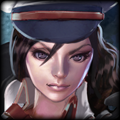 Catherine
Catherine-
 Catherine
Catherine and
 Glaive
Glaive can be deadly together, but require great synergy to pull off. Make sure you communicate with your team who is stunning first, as you don’t want to waste potential crowd control.
Lane Heroes to pair
 Glaive with:
Glaive with:
 Glaive
Glaive has good synergy with nearly every laner, but excels best with heroes that need peel or have good combos with
 Afterburn
Afterburn. Since
 Glaive
Glaive is weapon power, it is usually best to pair him with a CP laner, but
 Glaive
Glaive excels in double weapon compositions.
 Glaive
Glaive and
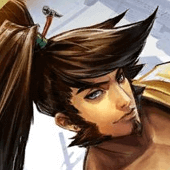 Ringo
Ringo are great together, as the immense burst is sure to kill one person immediately if executed properly.
 Glaive
Glaive is also extremely good with
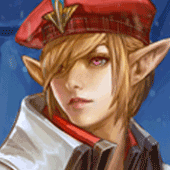 Kestrel
Kestrel, and CP lakers like
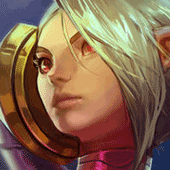 Celeste
Celeste that need peel and can combo very nicely with
 Afterburn
Afterburn into stuns.


In the current meta, it is usually best to play passively in the early game. Consider starting with
 Afterburn
Afterburn and rotating to lane after clearing the middle healing camp. Then, proceed to lane and try and catch the enemy laner by surprise with an afterburn from the bush. Be careful, however, of the enemy jungler roaming up to lane, as he will have a shop advantage. If the gank was successful, rotate with your team down to jungle shop. If not, go back to base to shop or if you think it is safe to shop in jungle, go there and continue with your rotation.

 Glaive
Glaive starts spiking once
 Afterburn
Afterburn is overdriven and
 Bloodsong
Bloodsong is available and fully stacked. In the mid-game, it is essential to keep pressure on the lane, especially if you have not taken a turret yet. Use the added lane pressure to rotate as a team through jungle, taking camps and objectives. Make sure that you have full or close to full
 Bloodsong
Bloodsong stacks before engaging in any fight or skirmish. Depending on the enemy composition, you can either peel back for your laner and do damage from the mid-line or hard engage into the enemy team. If the enemy team has a dive heavy comp, peel back for the laner with
 Afterburn
Afterburn. Otherwise, engage the enemy team and try to
 Afterburn
Afterburn the enemy laner out of position. Be careful, however, of overextending. A failed
 Afterburn
Afterburn or Afterburning too early will leave you in a vulnerable position that is likely to be capitalized on by the enemy. In the mid-game, you should have your sorrow blade completed, working towards a bonesaw and a t3 defensive item. Make sure to save enough money for infusions around the time Kraken spawns to gain a massive advantage in fights.

Don’t engage with
 Afterburn
Afterburn. engage with boots or support wartreads. if someone is trying to run away you can catch them
 Glaive
Glaive begins to fall off in the late game, especially if you don’t have your bonesaw. If you are behind, or the game is even, your primary objective should be to keep your laner safe. You will likely get bursted down trying to engage, so peel back for the laner and capitalize when the enemy over extends. If you have a mage laner especially, devote all your resources to keeping him alive, as your extra peel will allow them to carry you through the teamfight. Be careful not to overextend yourself, even if you are ahead, as one bad engage could be devastating for your team and possibly lose the game.















 In the current meta, it is usually best to play passively in the early game. Consider starting with
In the current meta, it is usually best to play passively in the early game. Consider starting with 
 Don’t engage with
Don’t engage with 
 Thank you for reading! I hope you found it useful. Send any questions you may have to
Thank you for reading! I hope you found it useful. Send any questions you may have to
Quick Comment () View Comments
You need to log in before commenting.